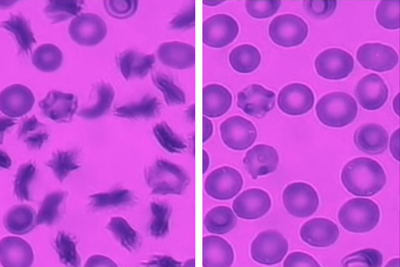January 19, 2015
 A multidisciplinary research team, led by Carnegie Mellon University President Subra Suresh, has developed a novel microfluidic device to assess cell-level processes influencing the pathophysiology of sickle cell disease (SCD), an inherited genetic disorder.
A multidisciplinary research team, led by Carnegie Mellon University President Subra Suresh, has developed a novel microfluidic device to assess cell-level processes influencing the pathophysiology of sickle cell disease (SCD), an inherited genetic disorder.
The team, comprising researchers from CMU, the University of Pittsburgh Medical Center (UPMC) and the Massachusetts Institute of Technology (MIT), designed this device to study blood samples from 25 SCD patients. In a paper published today in the Proceedings of the National Academy of Sciences, the researchers show how cell biophysical alterations during blood flow correlate with hematological parameters, sickle hemoglobin level and hydroxyurea therapy.
In addition to the research publication, a patent has been filed on the invention to further the potential of this method as a diagnostic indicator of disease severity and as a unique tool to gain a better understanding of the pathogenic basis and mechanism of drug response in SCD.
The team includes Dr. Gregory Kato, MD, director of the Adult Sickle Cell Center of Excellence and the Vascular Medicine Institute at UPMC; Dr. Ming Dao, principal research scientist, and Dr. Monica Diez-Silva, former research scientist, from the Department of Materials Science and Engineering at MIT; and lead author, Dr. E (Sarah) Du, formerly a post-doctoral fellow at MIT and currently on the faculty in the Department of Ocean and Mechanical Engineering at Florida Atlantic University in Boca Raton, Fla.
Patients with sickle cell disease often suffer from painful attacks known as vaso-occlusive crises, during which their sickle-shaped blood cells get stuck in tiny capillaries, depriving tissues of needed oxygen. Blood transfusions can sometimes prevent such attacks, but there are currently no good ways to predict when a vaso-occlusive crisis, which can last for several days, is imminent.
"You don't know exactly when it's going to happen or how to reliably predict it is coming," Dao said.
Now, Dao and colleagues, including CMU President Suresh, former dean of MIT's School of Engineering and the Vannevar Bush Professor of Engineering Emeritus, have developed a tiny microfluidic device that can analyze the behavior of blood from sickle cell disease patients. This device can measure how long it takes blood cells to become dangerously stiff, making them more likely to get trapped in blood vessels.
Learn more and watch the video.
###
Above Image:
As red blood cells from sickle cell patients flow through the new microfluidic device, many of them become sickled following exposure to a low-oxygen environment (left). At right, when oxygen levels are restored, the cells resume their normal shape. Credit: E. Du, M. Diez-Silva, G. Kato, M. Dao and S. Suresh
Researchers Develop New Way To Model Sickle Cell Behavior
 A multidisciplinary research team, led by Carnegie Mellon University President Subra Suresh, has developed a novel microfluidic device to assess cell-level processes influencing the pathophysiology of sickle cell disease (SCD), an inherited genetic disorder.
A multidisciplinary research team, led by Carnegie Mellon University President Subra Suresh, has developed a novel microfluidic device to assess cell-level processes influencing the pathophysiology of sickle cell disease (SCD), an inherited genetic disorder. The team, comprising researchers from CMU, the University of Pittsburgh Medical Center (UPMC) and the Massachusetts Institute of Technology (MIT), designed this device to study blood samples from 25 SCD patients. In a paper published today in the Proceedings of the National Academy of Sciences, the researchers show how cell biophysical alterations during blood flow correlate with hematological parameters, sickle hemoglobin level and hydroxyurea therapy.
In addition to the research publication, a patent has been filed on the invention to further the potential of this method as a diagnostic indicator of disease severity and as a unique tool to gain a better understanding of the pathogenic basis and mechanism of drug response in SCD.
The team includes Dr. Gregory Kato, MD, director of the Adult Sickle Cell Center of Excellence and the Vascular Medicine Institute at UPMC; Dr. Ming Dao, principal research scientist, and Dr. Monica Diez-Silva, former research scientist, from the Department of Materials Science and Engineering at MIT; and lead author, Dr. E (Sarah) Du, formerly a post-doctoral fellow at MIT and currently on the faculty in the Department of Ocean and Mechanical Engineering at Florida Atlantic University in Boca Raton, Fla.
Patients with sickle cell disease often suffer from painful attacks known as vaso-occlusive crises, during which their sickle-shaped blood cells get stuck in tiny capillaries, depriving tissues of needed oxygen. Blood transfusions can sometimes prevent such attacks, but there are currently no good ways to predict when a vaso-occlusive crisis, which can last for several days, is imminent.
"You don't know exactly when it's going to happen or how to reliably predict it is coming," Dao said.
Now, Dao and colleagues, including CMU President Suresh, former dean of MIT's School of Engineering and the Vannevar Bush Professor of Engineering Emeritus, have developed a tiny microfluidic device that can analyze the behavior of blood from sickle cell disease patients. This device can measure how long it takes blood cells to become dangerously stiff, making them more likely to get trapped in blood vessels.
Learn more and watch the video.
###
Above Image:
As red blood cells from sickle cell patients flow through the new microfluidic device, many of them become sickled following exposure to a low-oxygen environment (left). At right, when oxygen levels are restored, the cells resume their normal shape. Credit: E. Du, M. Diez-Silva, G. Kato, M. Dao and S. Suresh